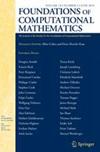使用二元公式对动态优化运输进行离散化的定量收敛
IF 2.7
1区 数学
Q2 COMPUTER SCIENCE, THEORY & METHODS
引用次数: 0
摘要
我们提出了一种动态优化运输问题的离散化方法,当时间和空间步长消失时,我们可以得到运输成本值到其连续值的收敛速率。这一收敛结果不需要任何关于度量的正则性假设,尽管实验表明该收敛率并不尖锐。通过对偶性差距的分析,我们还得到了在温和的正则性假设下最优势梯度和速度场的收敛率。为了获得这样的收敛率,我们对动态最优传输问题的对偶表述进行了离散化,并使用了与汉密尔顿-雅可比方程离散化误差相关的成熟文献。本文章由计算机程序翻译,如有差异,请以英文原文为准。
Quantitative Convergence of a Discretization of Dynamic Optimal Transport Using the Dual Formulation
We present a discretization of the dynamic optimal transport problem for which we can obtain the convergence rate for the value of the transport cost to its continuous value when the temporal and spatial stepsize vanish. This convergence result does not require any regularity assumption on the measures, though experiments suggest that the rate is not sharp. Via an analysis of the duality gap we also obtain the convergence rates for the gradient of the optimal potentials and the velocity field under mild regularity assumptions. To obtain such rates, we discretize the dual formulation of the dynamic optimal transport problem and use the mature literature related to the error due to discretizing the Hamilton–Jacobi equation.
求助全文
通过发布文献求助,成功后即可免费获取论文全文。
去求助
来源期刊

Foundations of Computational Mathematics
数学-计算机:理论方法
CiteScore
6.90
自引率
3.30%
发文量
46
审稿时长
>12 weeks
期刊介绍:
Foundations of Computational Mathematics (FoCM) will publish research and survey papers of the highest quality which further the understanding of the connections between mathematics and computation. The journal aims to promote the exploration of all fundamental issues underlying the creative tension among mathematics, computer science and application areas unencumbered by any external criteria such as the pressure for applications. The journal will thus serve an increasingly important and applicable area of mathematics. The journal hopes to further the understanding of the deep relationships between mathematical theory: analysis, topology, geometry and algebra, and the computational processes as they are evolving in tandem with the modern computer.
With its distinguished editorial board selecting papers of the highest quality and interest from the international community, FoCM hopes to influence both mathematics and computation. Relevance to applications will not constitute a requirement for the publication of articles.
The journal does not accept code for review however authors who have code/data related to the submission should include a weblink to the repository where the data/code is stored.
 求助内容:
求助内容: 应助结果提醒方式:
应助结果提醒方式:


